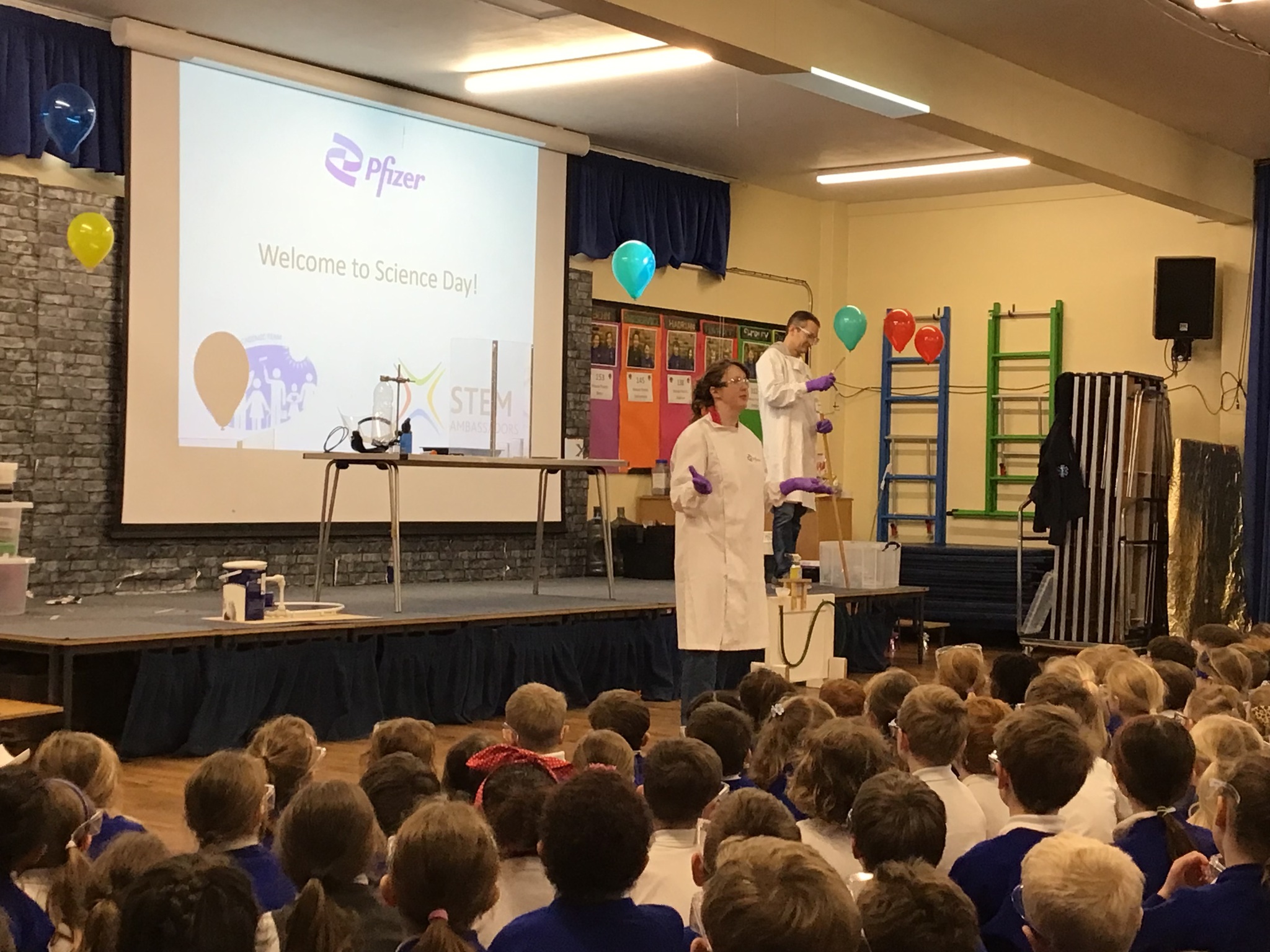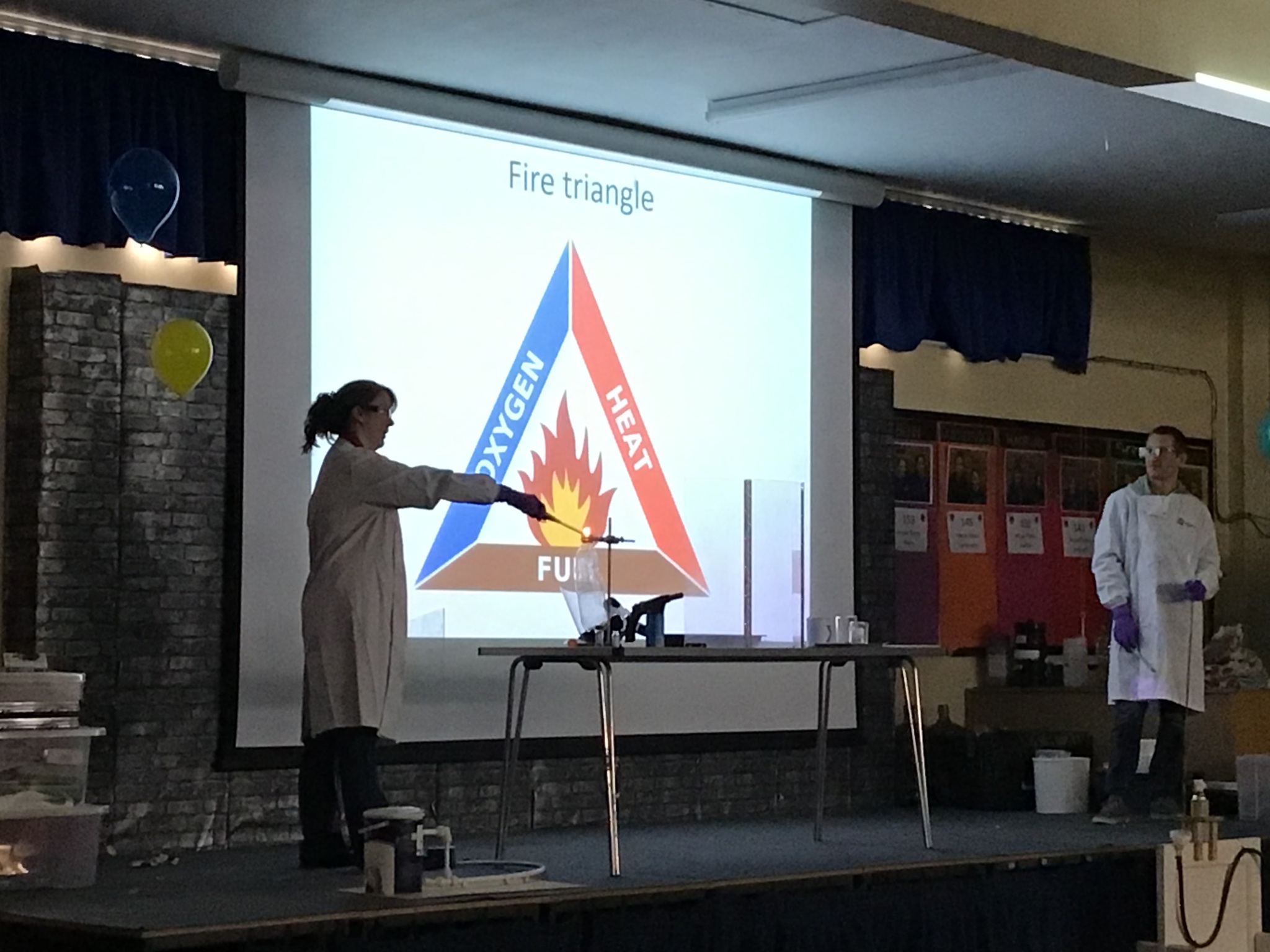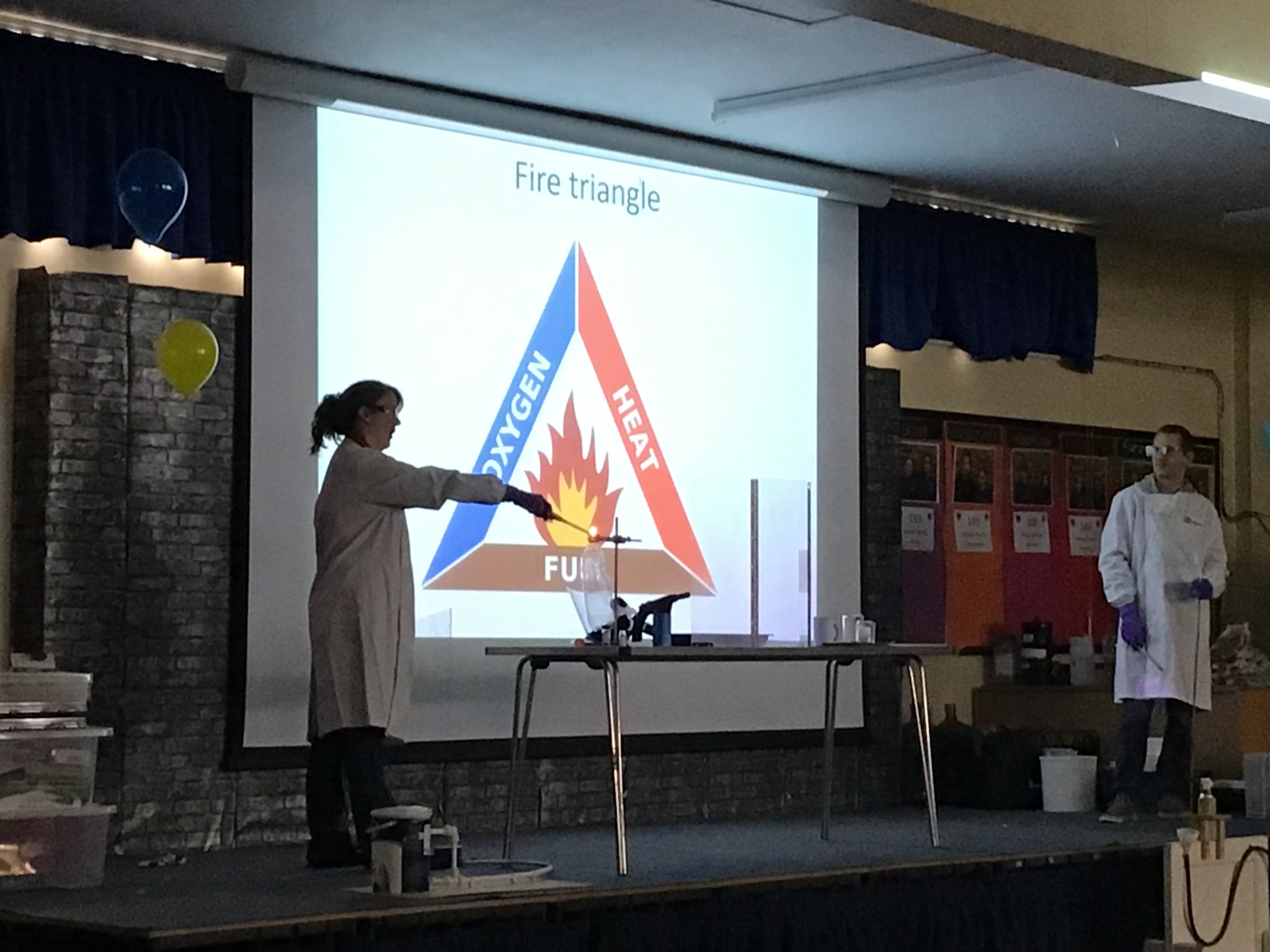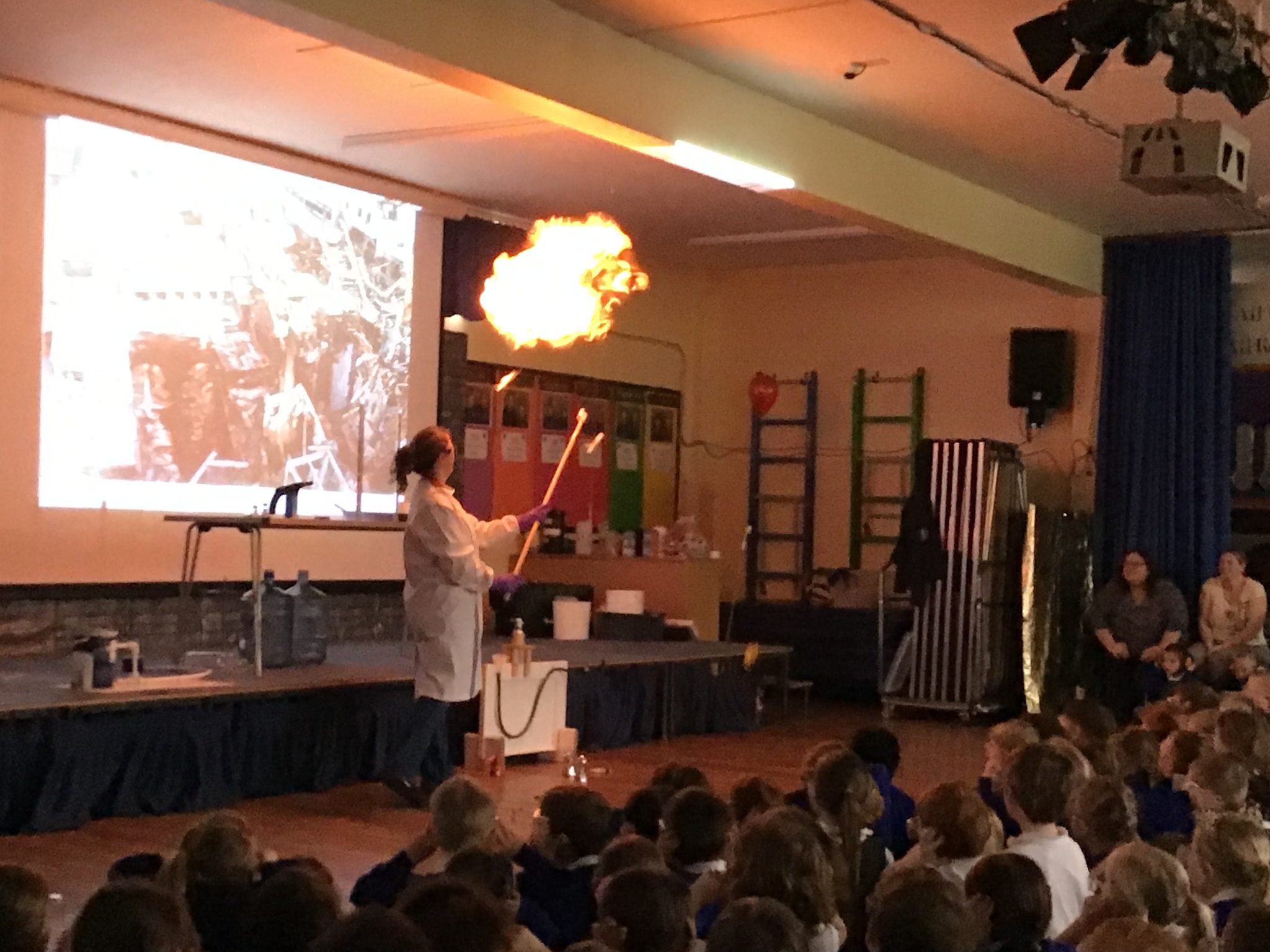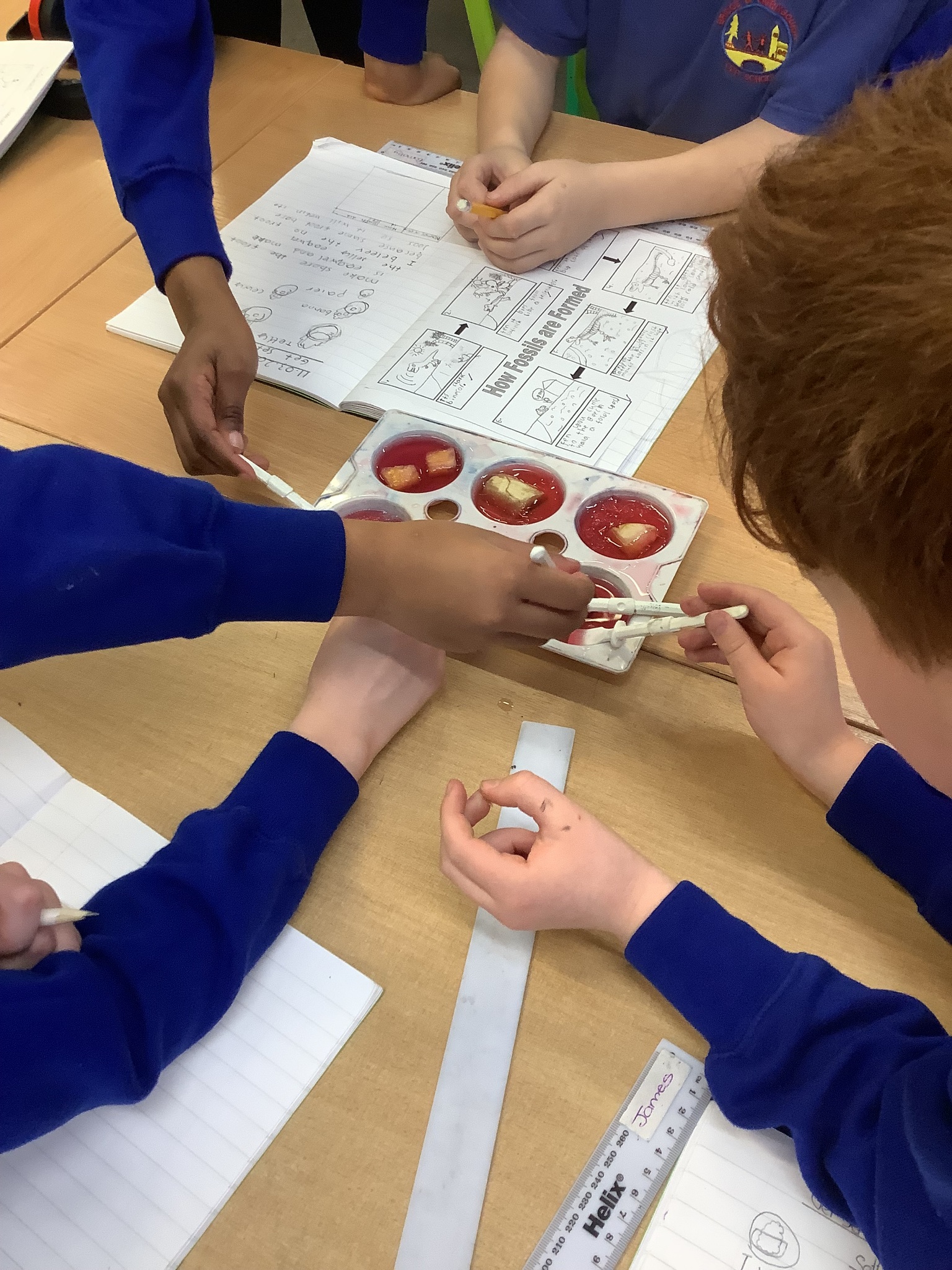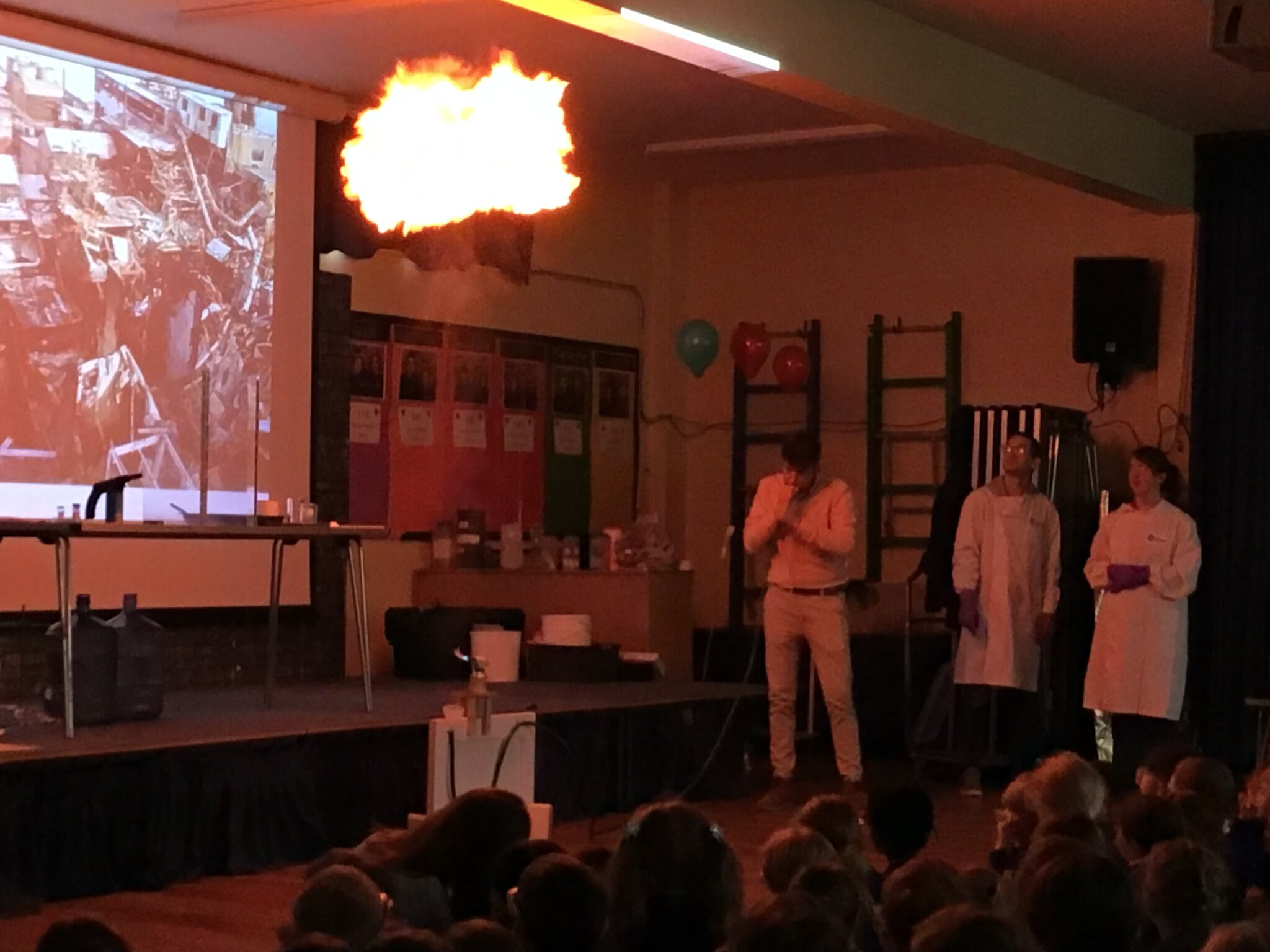
There was great excitement around the school last week as it was Science Week. The week started with all classes taking part in an investigation called Get Set Jellies! The children had to investigate which of the fruits provided would stop the jelly from setting. As a class they had to decide how to set up the investigation, make predictions, record their results and explain what they had found out.
On Wednesday, we had a very exciting start to the day with an assembly all about fire run by a group from Pfizers. There was a lot of excitement, gasps in amazement and cheers in the hall as each experiment took place to help the children understand about the fire triangle. The children learnt that in order to create fire there needed to be oxygen, fuel and heat. Year 5 and 6 were then lucky to be able to take part in two workshops led by a group from Pfizer.
Here is a summary from each year group on their findings from the Get Set Jellies investigation and other activities they took part in.
Reception
Reception had a fantastic time during Science Week! We started by predicting which fruit would make the best jelly and discussed why. Lots of us chose our favourite fruits, but some of us also chose fruits based on their colours and sweetness. We had one type of fruit per group, put it in to a cup of unset jelly, and checked to see how it set. We drew what we observed and decided which jelly was the most successful. We're also planning to use our observation skills on our Spring Walk next week. We're going to walk around Bridge village and spot signs of seasonal changes as we move from Spring to Winter.
Year 1
Today we had great fun investigating jelly! We started our investigation by looking at the five different fruits that we will be using in our investigation. We then predicted which fruit would set the quickest and which would set the slowest. We also discussed, as a class, why we had chosen a particular fruit in our predictions. Many people agreed that bananas and kiwi would set the quickest because they are both very soft fruits. The majority of the class predicted that the harder fruits – apples, pears and the pineapple – would take longer to set, with a few children stating that they didn’t think they would set at all because they were too hard!
In groups, we then made the five different jellies. We decided to do a control jelly without any fruit mixed in to see if this would set even quicker! As a class, we decided to check on the fruit, once it was placed in the fridge, every half an hour.
We recorded our results in a table and found that the jelly with pears set the quickest, whilst the pineapple and kiwi didn’t set at all! In fact, both these jellies looked exactly the same as when we put it them in the fridge six hours earlier! The control jelly was actually the third quickest to set.
Year 2
Year 2 had lots of fun exploring whether different fruits would alter the way jelly set. They came up with some interesting predictions - the apple jelly wouldn't set because the apple was too hard, the banana wouldn't set because it was too squishy. One child thought the apple would absorb all the jelly! In the end, the apple, pineapple and kiwi didn't set. Those that predicted the apple wouldn't set were correct but not necessarily for the right reasons. Interestingly, the banana jelly set the hardest - even harder than the control jelly with no fruit in it. We found out that pineapple had bromelain in it which causes the jelly to turn into a liquid. The children really enjoyed the investigation and discussions!
Year 3
There was great excitement in Year 3 about the jelly investigation. We began by thinking about how we could investigate whether different fruits would affect the jelly setting. We decided to have a control (plain jelly) and also decided in order to make it a fair test we needed to make sure the size of the fruit was the same and that the tray had the same amount of jelly in each section. The children thought hard about their predictions and many thought the setting process would be affected by how much water or juice each piece of fruit contained. After leaving the jelly overnight, the children had great fun testing the jelly to see how much it had set. The children found out that the jelly with the kiwi and pineapple in was still watery and had not set at all. The children thought of detailed explanations on why this might have happened again linked to the water content in each fruit. We then spent some time learning that pineapple contains bromelain which breaks down protein which stops the jelly from setting.
Year 4
Science week in Year 4 was great fun! We had 3 science lessons throughout the week, all of which the children enjoyed taking part in. We started off by introducing the whole school jelly investigation: ‘Does adding fruit to jelly impact on the time taken to set?’. We completed this investigation as a class and made some interesting discoveries, most importantly that if you want your jelly to set quickly, do not use pineapple or kiwi! We then undertook an investigation based around sound waves which required the children to make paper cup and string telephones and answer a variety of questions using them. Needless to say, the children thoroughly enjoyed the practical side of this lesson. Finally, the children were given the task of creating ways to encourage more wildlife into our school grounds, thinking carefully about what type of wildlife they would like to see more of and how they could achieve this. We worked in pairs to re-design the school grounds with some excellent ‘birds-eye-view’ annotated maps created.
Year 5
In Year 5, we worked in groups to investigate the impact of adding fruit to jelly on how quickly it set. We used a numbered system to evaluate how 'set' the jelly was and the children recorded their learning in tables. From this, they were able to draw conclusions about what fruit had the biggest impact. This gave room for lots of scientific vocabulary and discussions around the acidity of different fruits. On Wednesday, after the exciting whole-school assembly with Pfizer, we were lucky to have class sessions with the scientists where the children got the opportunity to make 'Elephant's Toothpaste' or feel fire on their hands. It was great to see the children engaged and excited, dressed up in lab coats, goggles and gloves. The children learnt lots about different chemicals and reactions, as well as important safety measures for when conducting experiments.
Year 6
From Lillian, Lily and Phoebe in Year 6.
We really enjoyed the science week Pfizer experience. In one classroom we made elephant toothpaste using soap and yeast as two of the main active ingredients. In the other classroom we experimented with chemicals to make coloured fire. Overall it was a great experience and a huge thank you to Mrs Dennett.
There was great excitement around the school last week as it was Science Week. The week started with all classes taking part in an investigation called Get Set Jellies! The children had to investigate which of the fruits provided would stop the jelly from setting. As a class they had to decide how to set up the investigation, make predictions, record their results and explain what they had found out.
On Wednesday, we had a very exciting start to the day with an assembly all about fire run by a group from Pfizers. There was a lot of excitement, gasps in amazement and cheers in the hall as each experiment took place to help the children understand about the fire triangle. The children learnt that in order to create fire there needed to be oxygen, fuel and heat. Year 5 and 6 were then lucky to be able to take part in two workshops led by a group from Pfizer.
Here is a summary from each year group on their findings from the Get Set Jellies investigation and other activities they took part in.
Reception
Reception had a fantastic time during Science Week! We started by predicting which fruit would make the best jelly and discussed why. Lots of us chose our favourite fruits, but some of us also chose fruits based on their colours and sweetness. We had one type of fruit per group, put it in to a cup of unset jelly, and checked to see how it set. We drew what we observed and decided which jelly was the most successful. We're also planning to use our observation skills on our Spring Walk next week. We're going to walk around Bridge village and spot signs of seasonal changes as we move from Spring to Winter.
Year 1
Today we had great fun investigating jelly! We started our investigation by looking at the five different fruits that we will be using in our investigation. We then predicted which fruit would set the quickest and which would set the slowest. We also discussed, as a class, why we had chosen a particular fruit in our predictions. Many people agreed that bananas and kiwi would set the quickest because they are both very soft fruits. The majority of the class predicted that the harder fruits – apples, pears and the pineapple – would take longer to set, with a few children stating that they didn’t think they would set at all because they were too hard!
In groups, we then made the five different jellies. We decided to do a control jelly without any fruit mixed in to see if this would set even quicker! As a class, we decided to check on the fruit, once it was placed in the fridge, every half an hour.
We recorded our results in a table and found that the jelly with pears set the quickest, whilst the pineapple and kiwi didn’t set at all! In fact, both these jellies looked exactly the same as when we put it them in the fridge six hours earlier! The control jelly was actually the third quickest to set.
Year 2
Year 2 had lots of fun exploring whether different fruits would alter the way jelly set. They came up with some interesting predictions - the apple jelly wouldn't set because the apple was too hard, the banana wouldn't set because it was too squishy. One child thought the apple would absorb all the jelly! In the end, the apple, pineapple and kiwi didn't set. Those that predicted the apple wouldn't set were correct but not necessarily for the right reasons. Interestingly, the banana jelly set the hardest - even harder than the control jelly with no fruit in it. We found out that pineapple had bromelain in it which causes the jelly to turn into a liquid. The children really enjoyed the investigation and discussions!
Year 3
There was great excitement in Year 3 about the jelly investigation. We began by thinking about how we could investigate whether different fruits would affect the jelly setting. We decided to have a control (plain jelly) and also decided in order to make it a fair test we needed to make sure the size of the fruit was the same and that the tray had the same amount of jelly in each section. The children thought hard about their predictions and many thought the setting process would be affected by how much water or juice each piece of fruit contained. After leaving the jelly overnight, the children had great fun testing the jelly to see how much it had set. The children found out that the jelly with the kiwi and pineapple in was still watery and had not set at all. The children thought of detailed explanations on why this might have happened again linked to the water content in each fruit. We then spent some time learning that pineapple contains bromelain which breaks down protein which stops the jelly from setting.
Year 4
Science week in Year 4 was great fun! We had 3 science lessons throughout the week, all of which the children enjoyed taking part in. We started off by introducing the whole school jelly investigation: ‘Does adding fruit to jelly impact on the time taken to set?’. We completed this investigation as a class and made some interesting discoveries, most importantly that if you want your jelly to set quickly, do not use pineapple or kiwi! We then undertook an investigation based around sound waves which required the children to make paper cup and string telephones and answer a variety of questions using them. Needless to say, the children thoroughly enjoyed the practical side of this lesson. Finally, the children were given the task of creating ways to encourage more wildlife into our school grounds, thinking carefully about what type of wildlife they would like to see more of and how they could achieve this. We worked in pairs to re-design the school grounds with some excellent ‘birds-eye-view’ annotated maps created.
Year 5
In Year 5, we worked in groups to investigate the impact of adding fruit to jelly on how quickly it set. We used a numbered system to evaluate how 'set' the jelly was and the children recorded their learning in tables. From this, they were able to draw conclusions about what fruit had the biggest impact. This gave room for lots of scientific vocabulary and discussions around the acidity of different fruits. On Wednesday, after the exciting whole-school assembly with Pfizer, we were lucky to have class sessions with the scientists where the children got the opportunity to make 'Elephant's Toothpaste' or feel fire on their hands. It was great to see the children engaged and excited, dressed up in lab coats, goggles and gloves. The children learnt lots about different chemicals and reactions, as well as important safety measures for when conducting experiments.
Year 6
From Lillian, Lily and Phoebe in Year 6.
We really enjoyed the science week Pfizer experience. In one classroom we made elephant toothpaste using soap and yeast as two of the main active ingredients. In the other classroom we experimented with chemicals to make coloured fire. Overall it was a great experience and a huge thank you to Mrs Dennett.
